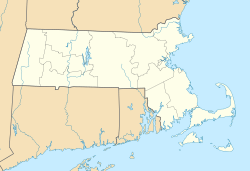Blackstone Viaduct facts for kids
Quick facts for kids |
|
|
Blackstone Viaduct
|
|
 |
|
| Location | Blackstone, Massachusetts |
|---|---|
| Area | 2.91 acres (1.18 ha) |
| Built | 1872 |
| Architect | Boston, Hartford & Erie RR; American Bridge Company |
| NRHP reference No. | 01001558 |
| Added to NRHP | February 5, 2002 |
The Blackstone Viaduct is a very old and important bridge structure in Blackstone, Massachusetts. It is also known as the New York & New England Railroad Viaduct. A viaduct is like a long bridge that carries a road or railway over a valley or other low ground. This one was built for trains!
It was constructed in 1872 by two companies: the Boston, Hartford and Erie Railroad and the American Bridge Company. The viaduct is about 1,600 feet (488 meters) long. It includes strong stone arches and raised sections made of earth.
What is the Blackstone Viaduct?
The Blackstone Viaduct stretches across the land in Blackstone, Massachusetts. It starts near the Blackstone River on its eastern side. Then it goes all the way to a part of the old Blackstone Canal on its western side.
A big part of the viaduct is an 800-foot (244-meter) long raised earth section. This section is about 25 feet (7.6 meters) high. After that, there's a 375-foot (114-meter) long bridge with many arches. This bridge was built from strong granite stone. Later, in 1918, it was covered with concrete to make it even stronger.
In 2002, the Blackstone Viaduct was added to the National Register of Historic Places. This means it's recognized as an important historical site in the United States.
Why Was It Built?
The viaduct was a key part of a big plan by the Boston, Hartford and Erie (BH&E) railroad company. They wanted to build a complete train route between New York City and Boston.
The first part of this route, from Blackstone to Boston, opened in 1849. The BH&E company bought this section in 1867. They then worked to connect Blackstone all the way to New Haven, Connecticut. This connection was finished in 1873. The Blackstone Viaduct was built as part of this new connection. It replaced an older wooden bridge that was there before.
Repairs and Importance
Over time, some parts of the viaduct's arches started to wear out. So, in 1918, they were made stronger with concrete. Also, the bridge section that went over Canal Street was replaced in 1917.
The Blackstone Viaduct is one of the largest stone bridges built in Massachusetts during the 1800s. It's second in size only to the famous Canton Viaduct. It stands as a reminder of the important role railroads played in connecting cities long ago.



